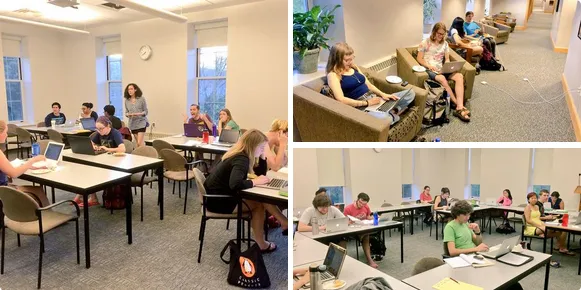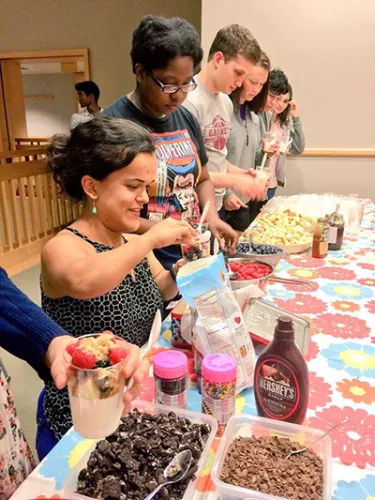International Write-In Offers Students Support, Solidarity

The third floor of Trotter Hall saw a lot of breakthroughs this past Monday between 3 p.m. and midnight. Around 80 students stopped by for the International Write-In, hosted by the Writing Associates (WA) Program and featuring a parfait bar and a band of WAs to offer support as their peers tackled end-of-semester papers.
Last December marked the first official International Write-In, named after the simultaneous participation by schools in various countries around the world. Although no international schools are holding affiliated write-ins during the 10-day period this semester, some will do so a few days later, so the name stuck.
The initial International Write-In was born out of a joking question, says Jill Gladstein, associate professor of English literature and director of the WA program: “What would make this the mother of all write-ins?” The answer turned out to be reaching out to as many other institutions of higher learning as possible and developing an unprecedented network over social media that supports each other’s writing goals.

The parfait bar at this year's International Write-In
WA alumnus Cameron French '14, currently at NYU Shanghai, and Naudia Williams '14 at NYU Abu Dhabi have expanded the program to those regions. WA Program Coordinator Josh Throckmorton helped to standardize the write-in event by creating an official guide and sharing it with other schools. The guide was shared even more broadly after it was translated into Spanish by a woman from Colombia, who then shared it with schools in Latin America.
This time, the Write-In includes 42 participating schools, ranging in size, geography, and culture. The list includes liberal arts schools, large private universities, public state universities, and community colleges. At Swarthmore, students lined up at 3 p.m. to join the WAs (and snacks) on Trotter third, and both the main room and reserved quiet room stayed full for most of the day.
“I think why people like a write-in is that they get to come together in a shared space, but they’re not actively engaging with each other,” says Gladstein.
Throckmorton agrees that the communal aspect is key.
“The main goal from our perspective is to unite writers across campus," he says, "to show them that they don’t have to write alone.”
He remembers gathering with friends as an undergraduate at Occidental College to silently support one another through the writing process.
“Writing is a very personal thing, and the process of writing can feel isolating at times because it’s so personal," says Throckmorton. “What a writing center does is bring writers together and make them feel that they can go through this together."

A collage of posters promoting the event, which involved liberal arts schools, large public and private universities, and community colleges.
Not only are Swarthmore students writing together, but, thanks to social media, they are connecting with students from other schools doing the same thing. The hashtag #intlwritein has taken off, and participating schools have sent pictures of their posters for their write-ins, photos of students diligently writing, and even some photos of wild dancing study breaks. Different schools have obviously defined their write-ins in various ways.
In the past, one school’s write-in included a piñata, while another featured the participation of a plastic skeleton named Chuckles. A third school calmed students with a continuous stream of animal videos playing life-affirmingly in the background. Swarthmore’s de-stressing options included a separate room containing everything from coloring books to Bananagrams, the popular anagram word game. At the last write-in, technology helped connect these disparate relaxation techniques; Skype connected Swarthmore’s write-in to those happening at Occidental, Wittenberg University, and Franklin and Marshall College.
The write-in has expanded internally from Swarthmore, forming an interconnected web of productivity and (increasingly) creative study breaks.
“It’s taking off and becoming something other institutions are looking forward to,” Throckmorton says.
In fact, Cottey College, in Nevada, Mo., recently issued a tweet that warmed Throckmorton’s heart: “‘That was really helpful.’ ‘Can we have more of these?’ ‘I got so much done!’ (Students at the Writer’s Block Party) #intlwritein.”



